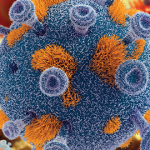Dr. Adebajo notes, “I would hope that existing rheumatology registries in different countries would be interested in looking at their patients who are HIV positive and collect information about them. In the long term, we need to actually develop registries to look specifically at HIV-positive patients with arthritis.”
Dr. Walker-Bone also suggests, “It would be good to explore the safety and efficacy of some of the more unusual analgesics (e.g., opiates and gabapentinoids) in HIV-infected patients taking cART.”
Currently, around 37 million individuals are living worldwide with HIV.22 As this population ages, more and more patients who are HIV positive will inevitably develop rheumatic disease, and the process of treating HIV will not become less pharmacologically complex any time soon. Rheumatologists will need to become comfortable treating these patients working in tandem with infectious disease doctors and other healthcare providers.
Ruth Jessen Hickman, MD, is a graduate of the Indiana University School of Medicine. She is a freelance medical and science writer living in Bloomington, Ind.
In Brief
Currently, around 37 million individuals are living with HIV worldwide. As this population ages, more and more patients who are HIV positive will inevitably develop rheumatic disease, and the process of treating HIV will not become less pharmacologically complex any time soon. Rheumatologists will need to become comfortable treating these patients working in tandem with infectious disease doctors and other healthcare providers.
References
- Adizie T, Moots RJ, Hodkinson B, et al. Inflammatory arthritis in HIV positive patients: A practical guide. BMC Infect Dis. 2016 Mar 1;16:100.
- Kallings LO. The first postmodern pandemic: 25 years of HIV/AIDS. J Intern Med. 2008 Mar;263(3):218–243.
- Fox C, Walker-Bone K. Evolving spectrum of HIV-associated rheumatic syndromes. Best Pract Res Clin Rheumatol. 2015 Apr;29(2):244–258.
- Walker-Bone K, Doherty E, Sanyal K, Churchill D. Assessment and management of musculoskeletal disorders among patients living with HIV. Rheumatology (Oxford). 2016. pii: kew418.
- Medina F, Pérez-Saleme L, Moreno J. Rheumatic manifestations of human immunodeficiency virus infection. Infect Dis Clin North Am. 2006 Dec;20(4):891–912.
- Yao Q, Frank M, Glynn M, Altman RD. Rheumatic manifestations in HIV-1 infected in-patients and literature review. Clin Exp Rheumatol. 2008 Sep–Oct;26(5):799–806.
- Walker UA, Tyndall A, Daikeler T. Rheumatic conditions in human immunodeficiency virus infection. Rheumatology (Oxford). 2008 Jul;47(7):952–959.
- Cahill S, Valadéz R. Growing older with HIV/AIDS: New public health challenges. Am J Public Health. 2013 Mar;103(3):e7–e15.
- Centers for Disease Control and Prevention. HIV among people age 50 and older.
- Hochberg MC, Fox R, Nelson KE, et al. HIV infection is not associated with Reiter’s syndrome: Data from the Johns Hopkins Multicenter AIDS cohort study. AIDS. 1990 Nov;4(11):1149–1151.
- Lawson E, Sabin C, Perry N, et al. Is HIV painful? An epidemiologic study of the prevalence and risk factors for pain in HIV-infected patients. Clin J Pain. 2014 Oct 17. Doi: 10.1097/AJP.0000000000000162.
- Arnaudo E, Dalakas M, Shanske S, et al. Depletion of muscle mitochondrial DNA in AIDS patients with zidovudine-induced myopathy. Lancet. 1991 Mar 2;337(8740):508–510.
- Mody G, Parke F. Articular manifestations of human immunodeficiency virus infection. Best Pract Res Clin Rheumatol. 2003 Apr;17(2):265–287.
- Virot E, Duclos A, Adelaide L, et al. Autoimmune diseases and HIV infection: A cross-sectional study. Medicine (Baltimore). 2017 Jan;96(4):e5769.
- Du Toit R, Whitelaw D, Taljaard JJ, et al. Lack of specificity of anticyclic citrullinated peptide antibodies in advanced human immunodeficiency virus infection. J Rheumatol. 2011 Jun;38(6):1055–1060.
- Carroll MB, Fields JH, Clerc PG. Rheumatoid arthritis in patients with HIV: Management challenges. Open Access Rheumatol. 2016 Apr 29;8:51–59.
- Ghrenassia E, Martis N, Boyer J, et al. The diffuse infiltrative lymphocytosis syndrome (DILS). A comprehensive review. J Autoimmun. 2015 May;59:19–25.
- Tappuni AR. Immune reconstitution inflammatory syndrome. Adv Dent Res. 2011 Apr;23(1):90–96.
- Gedmintas L, Solomon DH. HIV and its effects on bone: A primer for rheumatologists. Curr Opin Rheumatol. 2012 Sep;24(5):567–575.
- Chokotho L, Harrison WJ, Lubega N, Mkandawire NC. Avascular necrosis of the femoral head in HIV positive patients—an assessment of risk factors and early response to surgical treatment. Malawi Med J. 2013 Jun;25(2):28–32.
- Brown TT, Hoy J, Borderi M, et al. Recommendations for evaluation and management of bone disease in HIV. Clin Infect Dis. 2015 Apr 15;60(8):1242–1251.
- HIV drug interactions. University of Liverpool. Mission Statement.
- U.S. Food and Drug Administration. Antiretroviral drugs used in the treatment of HIV infection.
- Panel on Antiretroviral Guidelines for Adults and Adolescents. Guidelines for the use of antiretroviral agents in HIV-1-infected adults and adolescents. Department of Health and Human Services.
- U.S. Food and Drug Administration. Information for health care professionals: New safety information for colchicine (marketed as Colcrys).
- Wangsiricharoen S, Ligon C, Gedmintas L, et al. Rates of serious infections in HIV-infected patients receiving tumor necrosis factor inhibitor therapy for concomitant autoimmune diseases. Arthritis Care Res (Hoboken). 2017 Mar;69(3):449–452.
- Branson BM, Handsfield HH, Lampe MA, et al. Revised recommendations for HIV testing of adults, adolescents, and pregnant women in health-care settings. MMWR Recomm Rep. 2006 Sep 22;55(RR14):1–17.
- Centers for Disease Control and Prevention. HIV/AIDS. Basic statistics.


